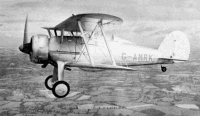Development: Air Ministry Specification
F.7/30 recognized that future fighters would have to be faster and better
armed, but the delay in placing an order extended to a disgraceful
4 1/2 years, by which time war
clouds were distantly gathering and the fabric-covered biplane was swiftly
to be judged obsolete. Folland's S.S.37 was built as a very late entrant.
long after the competition to F.7130 ought to have been settled. Though
less radical than most contenders it was eventually judged best and. as
the Gladiator, was at last ordered in July 1935. Features included neat
single-bay wings, each of the four planes having small hydraulically depressed
drag flaps; cantilever landing gear with Dowty internally sprung wheels;
four guns; and. in the production aircraft. a sliding cockpit canopy. Most
early production had the Watts wooden propeller, though performance was
better with the three-blade metal Fairey- Reed type. The Mk II aircraft
introduced desert filters. auto mixture control and electric starter from
internal battery. The Sea Gladiator had full carrier equipment and a dinghy.
Total production amounted to at least 767, including 480 for the RAF. |
